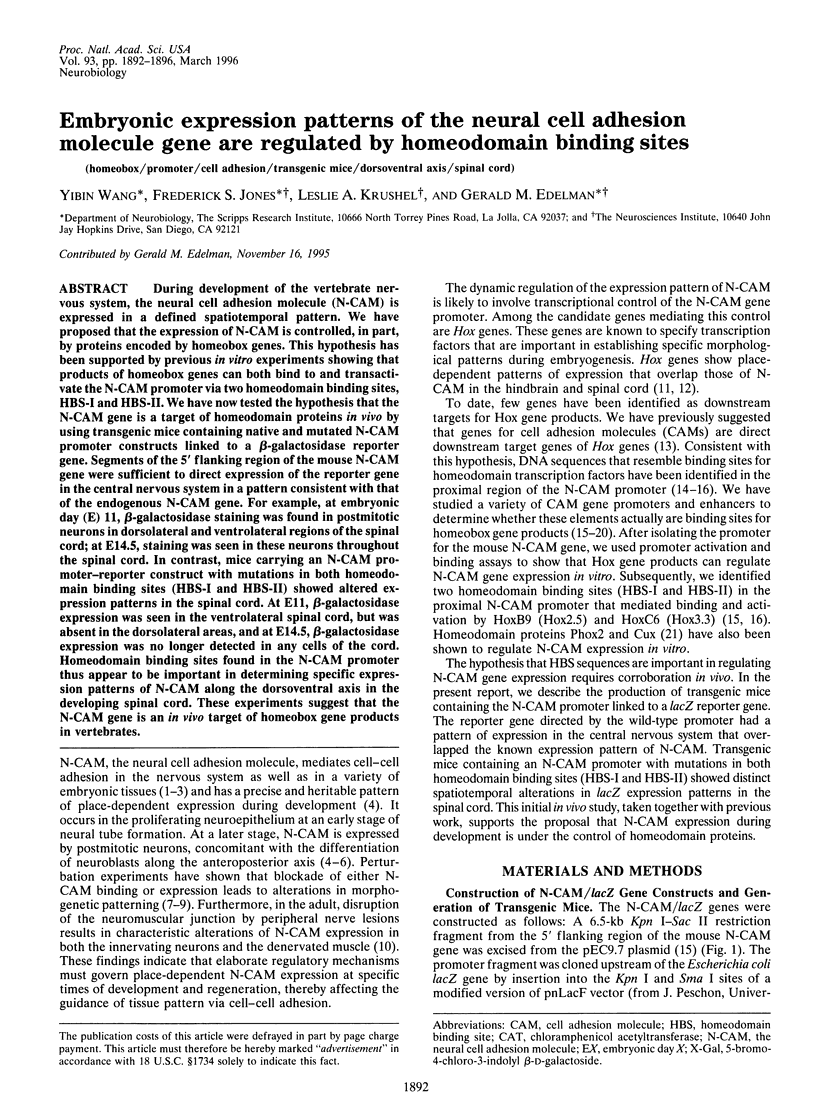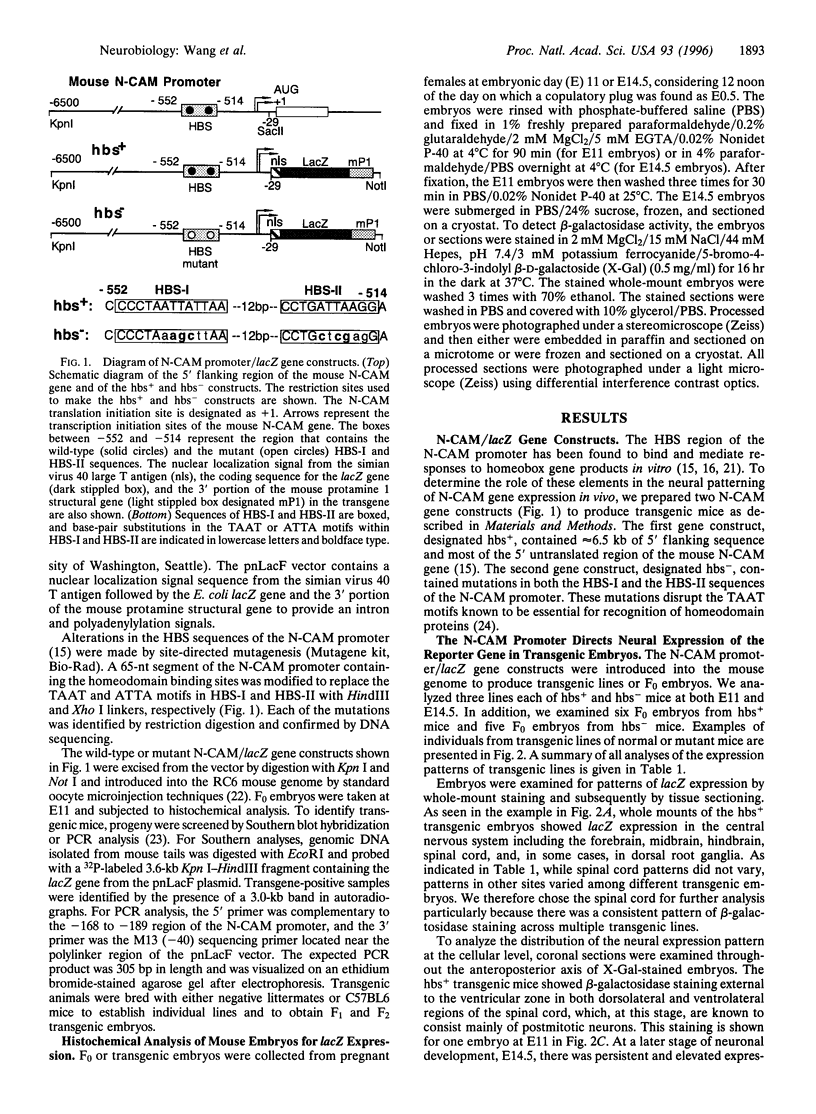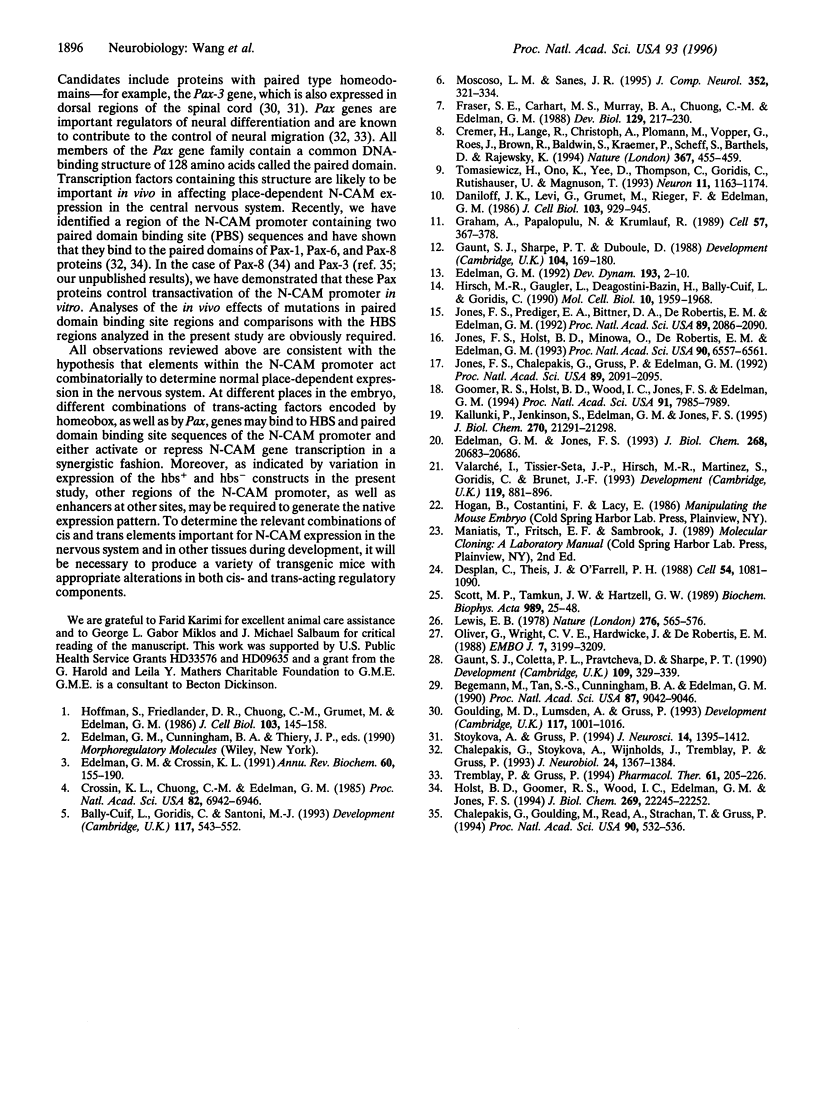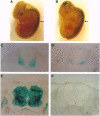Abstract
During development of the vertebrate nervous system, the neural cell adhesion molecule (N-CAM) is expressed in a defined spatiotemporal pattern. We have proposed that the expression of N-CAM is controlled, in part, by proteins encoded by homeobox genes. This hypothesis has been supported by previous in vitro experiments showing that products of homeobox genes can both bind to and transactivate the N-CAM promoter via two homeodomain binding sites, HBS-I and HBS-II. We have now tested the hypothesis that the N-CAM gene is a target of homeodomain proteins in vivo by using transgenic mice containing native and mutated N-CAM promoter constructs linked to a beta-galactosidase reporter gene. Segments of the 5' flanking region of the mouse N-CAM gene were sufficient to direct expression of the reporter gene in the central nervous system in a pattern consistent with that of the endogenous N-CAM gene. For example, at embryonic day (E) 11, beta-galactosidase staining was found in postmitotic neurons in dorsolateral and ventrolateral regions of the spinal cord; at E14.5, staining was seen in these neurons throughout the spinal cord. In contrast, mice carrying an N-CAM promoter-reporter construct with mutations in both homeodomain binding sites (HBS-I and HBS-II) showed altered expression patterns in the spinal cord. At E11, beta-galactosidase expression was seen in the ventrolateral spinal cord, but was absent in the dorsolateral areas, and at E 14.5, beta-galactosidase expression was no longer detected in any cells of the cord. Homeodomain binding sites found in the N-CAM promoter thus appear to be important in determining specific expression patterns of N-CAM along the dorsoventral axis in the developing spinal cord. These experiments suggest that the N-CAM gene is an in vivo target of homeobox gene products in vertebrates.
Full text
PDF




Images in this article
Selected References
These references are in PubMed. This may not be the complete list of references from this article.
- Bally-Cuif L., Goridis C., Santoni M. J. The mouse NCAM gene displays a biphasic expression pattern during neural tube development. Development. 1993 Feb;117(2):543–552. doi: 10.1242/dev.117.2.543. [DOI] [PubMed] [Google Scholar]
- Begemann M., Tan S. S., Cunningham B. A., Edelman G. M. Expression of chicken liver cell adhesion molecule fusion genes in transgenic mice. Proc Natl Acad Sci U S A. 1990 Nov;87(22):9042–9046. doi: 10.1073/pnas.87.22.9042. [DOI] [PMC free article] [PubMed] [Google Scholar]
- Chalepakis G., Stoykova A., Wijnholds J., Tremblay P., Gruss P. Pax: gene regulators in the developing nervous system. J Neurobiol. 1993 Oct;24(10):1367–1384. doi: 10.1002/neu.480241009. [DOI] [PubMed] [Google Scholar]
- Cremer H., Lange R., Christoph A., Plomann M., Vopper G., Roes J., Brown R., Baldwin S., Kraemer P., Scheff S. Inactivation of the N-CAM gene in mice results in size reduction of the olfactory bulb and deficits in spatial learning. Nature. 1994 Feb 3;367(6462):455–459. doi: 10.1038/367455a0. [DOI] [PubMed] [Google Scholar]
- Crossin K. L., Chuong C. M., Edelman G. M. Expression sequences of cell adhesion molecules. Proc Natl Acad Sci U S A. 1985 Oct;82(20):6942–6946. doi: 10.1073/pnas.82.20.6942. [DOI] [PMC free article] [PubMed] [Google Scholar]
- Daniloff J. K., Levi G., Grumet M., Rieger F., Edelman G. M. Altered expression of neuronal cell adhesion molecules induced by nerve injury and repair. J Cell Biol. 1986 Sep;103(3):929–945. doi: 10.1083/jcb.103.3.929. [DOI] [PMC free article] [PubMed] [Google Scholar]
- Desplan C., Theis J., O'Farrell P. H. The sequence specificity of homeodomain-DNA interaction. Cell. 1988 Sep 23;54(7):1081–1090. doi: 10.1016/0092-8674(88)90123-7. [DOI] [PMC free article] [PubMed] [Google Scholar]
- Edelman G. M., Crossin K. L. Cell adhesion molecules: implications for a molecular histology. Annu Rev Biochem. 1991;60:155–190. doi: 10.1146/annurev.bi.60.070191.001103. [DOI] [PubMed] [Google Scholar]
- Edelman G. M., Jones F. S. Outside and downstream of the homeobox. J Biol Chem. 1993 Oct 5;268(28):20683–20686. [PubMed] [Google Scholar]
- Edelman G. M. Morphoregulation. Dev Dyn. 1992 Jan;193(1):2–10. doi: 10.1002/aja.1001930103. [DOI] [PubMed] [Google Scholar]
- Fraser S. E., Carhart M. S., Murray B. A., Chuong C. M., Edelman G. M. Alterations in the Xenopus retinotectal projection by antibodies to Xenopus N-CAM. Dev Biol. 1988 Sep;129(1):217–230. doi: 10.1016/0012-1606(88)90176-5. [DOI] [PubMed] [Google Scholar]
- Gaunt S. J., Coletta P. L., Pravtcheva D., Sharpe P. T. Mouse Hox-3.4: homeobox sequence and embryonic expression patterns compared with other members of the Hox gene network. Development. 1990 Jun;109(2):329–339. doi: 10.1242/dev.109.2.329. [DOI] [PubMed] [Google Scholar]
- Goomer R. S., Holst B. D., Wood I. C., Jones F. S., Edelman G. M. Regulation in vitro of an L-CAM enhancer by homeobox genes HoxD9 and HNF-1. Proc Natl Acad Sci U S A. 1994 Aug 16;91(17):7985–7989. doi: 10.1073/pnas.91.17.7985. [DOI] [PMC free article] [PubMed] [Google Scholar]
- Goulding M. D., Lumsden A., Gruss P. Signals from the notochord and floor plate regulate the region-specific expression of two Pax genes in the developing spinal cord. Development. 1993 Mar;117(3):1001–1016. doi: 10.1242/dev.117.3.1001. [DOI] [PubMed] [Google Scholar]
- Graham A., Papalopulu N., Krumlauf R. The murine and Drosophila homeobox gene complexes have common features of organization and expression. Cell. 1989 May 5;57(3):367–378. doi: 10.1016/0092-8674(89)90912-4. [DOI] [PubMed] [Google Scholar]
- Hirsch M. R., Gaugler L., Deagostini-Bazin H., Bally-Cuif L., Goridis C. Identification of positive and negative regulatory elements governing cell-type-specific expression of the neural cell adhesion molecule gene. Mol Cell Biol. 1990 May;10(5):1959–1968. doi: 10.1128/mcb.10.5.1959. [DOI] [PMC free article] [PubMed] [Google Scholar]
- Hoffman S., Friedlander D. R., Chuong C. M., Grumet M., Edelman G. M. Differential contributions of Ng-CAM and N-CAM to cell adhesion in different neural regions. J Cell Biol. 1986 Jul;103(1):145–158. doi: 10.1083/jcb.103.1.145. [DOI] [PMC free article] [PubMed] [Google Scholar]
- Holst B. D., Goomer R. S., Wood I. C., Edelman G. M., Jones F. S. Binding and activation of the promoter for the neural cell adhesion molecule by Pax-8. J Biol Chem. 1994 Sep 2;269(35):22245–22252. [PubMed] [Google Scholar]
- Jones F. S., Chalepakis G., Gruss P., Edelman G. M. Activation of the cytotactin promoter by the homeobox-containing gene Evx-1. Proc Natl Acad Sci U S A. 1992 Mar 15;89(6):2091–2095. doi: 10.1073/pnas.89.6.2091. [DOI] [PMC free article] [PubMed] [Google Scholar]
- Jones F. S., Holst B. D., Minowa O., De Robertis E. M., Edelman G. M. Binding and transcriptional activation of the promoter for the neural cell adhesion molecule by HoxC6 (Hox-3.3). Proc Natl Acad Sci U S A. 1993 Jul 15;90(14):6557–6561. doi: 10.1073/pnas.90.14.6557. [DOI] [PMC free article] [PubMed] [Google Scholar]
- Jones F. S., Prediger E. A., Bittner D. A., De Robertis E. M., Edelman G. M. Cell adhesion molecules as targets for Hox genes: neural cell adhesion molecule promoter activity is modulated by cotransfection with Hox-2.5 and -2.4. Proc Natl Acad Sci U S A. 1992 Mar 15;89(6):2086–2090. doi: 10.1073/pnas.89.6.2086. [DOI] [PMC free article] [PubMed] [Google Scholar]
- Kallunki P., Jenkinson S., Edelman G. M., Jones F. S. Silencer elements modulate the expression of the gene for the neuron-glia cell adhesion molecule, Ng-CAM. J Biol Chem. 1995 Sep 8;270(36):21291–21298. doi: 10.1074/jbc.270.36.21291. [DOI] [PubMed] [Google Scholar]
- Lewis E. B. A gene complex controlling segmentation in Drosophila. Nature. 1978 Dec 7;276(5688):565–570. doi: 10.1038/276565a0. [DOI] [PubMed] [Google Scholar]
- Moscoso L. M., Sanes J. R. Expression of four immunoglobulin superfamily adhesion molecules (L1, Nr-CAM/Bravo, neurofascin/ABGP, and N-CAM) in the developing mouse spinal cord. J Comp Neurol. 1995 Feb 13;352(3):321–334. doi: 10.1002/cne.903520302. [DOI] [PubMed] [Google Scholar]
- Oliver G., Wright C. V., Hardwicke J., De Robertis E. M. Differential antero-posterior expression of two proteins encoded by a homeobox gene in Xenopus and mouse embryos. EMBO J. 1988 Oct;7(10):3199–3209. doi: 10.1002/j.1460-2075.1988.tb03187.x. [DOI] [PMC free article] [PubMed] [Google Scholar]
- Scott M. P., Tamkun J. W., Hartzell G. W., 3rd The structure and function of the homeodomain. Biochim Biophys Acta. 1989 Jul 28;989(1):25–48. doi: 10.1016/0304-419x(89)90033-4. [DOI] [PubMed] [Google Scholar]
- Stoykova A., Gruss P. Roles of Pax-genes in developing and adult brain as suggested by expression patterns. J Neurosci. 1994 Mar;14(3 Pt 2):1395–1412. doi: 10.1523/JNEUROSCI.14-03-01395.1994. [DOI] [PMC free article] [PubMed] [Google Scholar]
- Tomasiewicz H., Ono K., Yee D., Thompson C., Goridis C., Rutishauser U., Magnuson T. Genetic deletion of a neural cell adhesion molecule variant (N-CAM-180) produces distinct defects in the central nervous system. Neuron. 1993 Dec;11(6):1163–1174. doi: 10.1016/0896-6273(93)90228-j. [DOI] [PubMed] [Google Scholar]
- Tremblay P., Gruss P. Pax: genes for mice and men. Pharmacol Ther. 1994;61(1-2):205–226. doi: 10.1016/0163-7258(94)90063-9. [DOI] [PubMed] [Google Scholar]
- Valarché I., Tissier-Seta J. P., Hirsch M. R., Martinez S., Goridis C., Brunet J. F. The mouse homeodomain protein Phox2 regulates Ncam promoter activity in concert with Cux/CDP and is a putative determinant of neurotransmitter phenotype. Development. 1993 Nov;119(3):881–896. doi: 10.1242/dev.119.3.881. [DOI] [PubMed] [Google Scholar]



